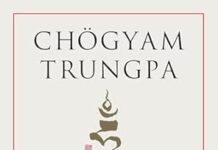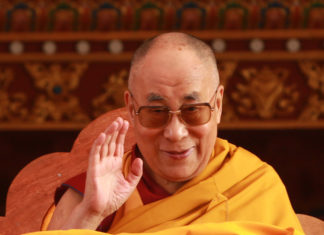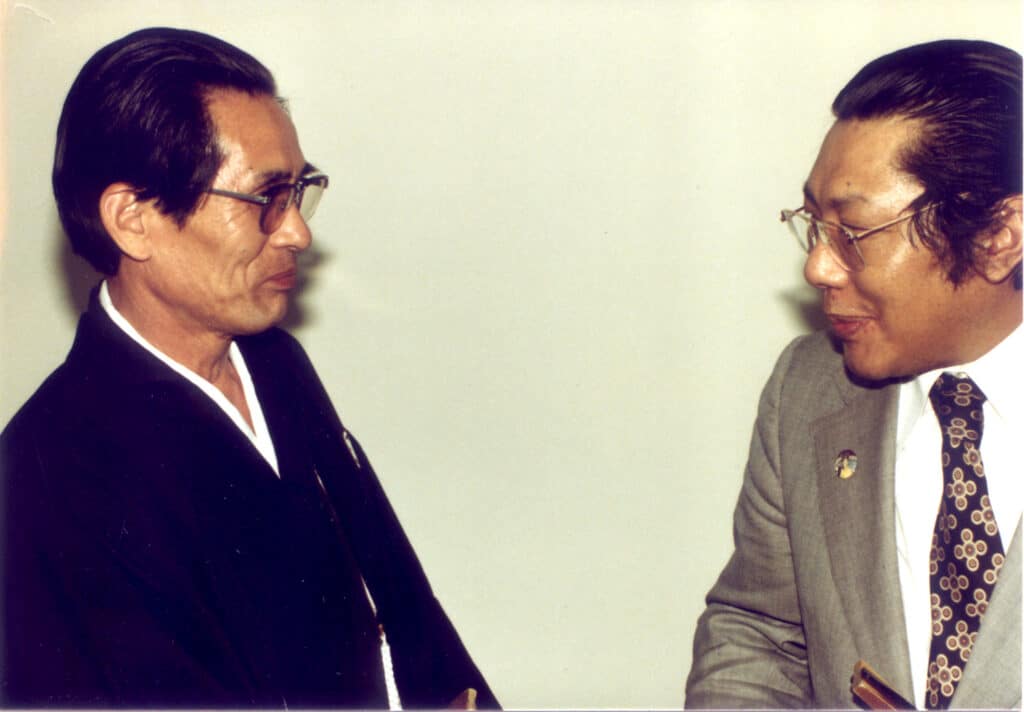
In the mid-1980s two meditation masters from different countries and traditions came together to create a beautiful and inspired work of art: a unique rock garden in the middle of an office building in an American business district. One was a Tibetan Buddhist meditation master, Vidyadhara Chögyam Trungpa Rinpoche, and the other was a Japanese teacher of Kyudo, Zen archery, Kanjuro Shibata Sensei.
In 1983, Nick Sbrocca, an architect and a commercial real estate developer, acquired a large building at 1800 30th Street in Boulder, Colorado. It was a steel frame barn of a building that contained a couple of tennis doubles courts and a singles court. At the front of the building was an office of more conventional construction. Nick developed a plan to convert the indoor tennis courts into an atrium with an oriental garden, while renovating the two floors around the tennis courts into offices and small businesses. Nick then arranged the financing for this.
Nick was a student of both Chögyam Trungpa Rinpoche and Kanjuro Shibata Sensei and knew some of their history of artistic creativity. In late 1970, Nick, along with the rest of the Pygmy hippie family, had met Rinpoche and became his student. At their first meeting, Rinpoche asked him, “Did you go to school?” Nick told him that he had just graduated from architecture school. Rinpoche seemed quite interested and said something like, “Oh, maybe we can do something together.”
Nick met Shibata Sensei on a trip to India via Japan with Robert Halpern in 1980. Kanjuro Shibata, Sensei was the 20th in a line of Zen archery masters of Japan, the commission bestowed on an earlier Kanjuro Shibata by the Meiji Emperor in 1889. Robert knew Sensei’s son Nobuhiro-san through the Zen communities in San Francisco and Los Alamos, California. On their way to India, Nick and Robert stopped in Japan and stayed with Shibata Sensei at his home. While there, Robert called Rinpoche, who agreed it would be a good idea to invite Shibata Sensei and his wife to visit him at the Vajradhatu Seminary, a three-month training program he was leading in Lake Louise, Canada. Sensei accepted the invitation.
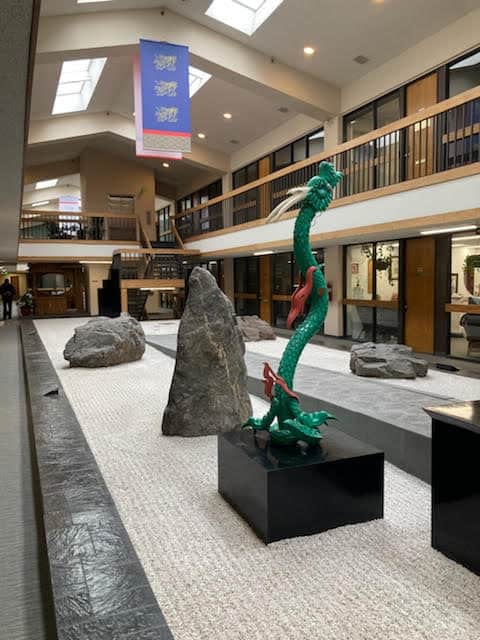
In the Spring 2006 issue of Elephant Journal, Scott Spanbauer wrote why the invitation to bring the Kyudo tradition to the West appealed to Sensei.
Sensei reminds his students to practice “mind kyudo, not sports kyudo,” and to give up hope and fear regarding hitting the target. As the emphasis on winning, rather than Zen mind, became prevalent in Japan, Sensei decided to accept an invitation by Trungpa Rinpoche in 1980 to teach in the West.
When Sensei arrived in Colorado and began teaching Kyudo, Nick became one of his first students along with Trungpa Rinpoche’s son, Sawang Ösel Mukpo, and others. In learning traditional Kyudo mind training, Nick and the Sawang also learned the ancient purification ritual of Shihoberai.
Based on his relationships with both teachers, Nick conceived of rock gardens in the space of his building where the tennis courts had been. He asked the two men if they would design the gardens and they agreed. In a series of meetings with them, Nick took notes and drew a rough plan of what they suggested. The garden was to have two parts: one side was to be “Heaven” designed by Rinpoche and the other was to be “Earth,” designed by Sensei. Nick hired Paul Wegener, the owner of Blue Sky Landscaping Company, to install the rocks as instructed by Rinpoche and Sensei. Mark Nowakowski was the foreman of the work crew and his brother Matt Nowakowski headed up the Earth side of the garden for Shibata Sensei.
Nick’s team arranged to cut two large holes in the building: one on the north end for the crane to deliver the large rocks and another on the south side to accommodate a conveyer belt used to bring in the sand and small to medium rocks. They also built the concrete block wall to surround the two gardens. The landscapers took over from there. The slab area on the south was left open to hold all the materials, except for the large rocks, which were placed as soon as they were delivered.
Heaven Garden
Mark and Paul remember some of the details that Rinpoche discussed at a meeting at the site about the Heaven garden. Nick, his assistant Tim Hennigan, and Paul, Mark and maybe others were there with Rinpoche, who described what he envisioned. Nick took notes and made a rough sketch.
Hector Maclean worked with Rinpoche on the layout of the walkway. Rinpoche wanted a symbolic replica of the ramp to the Imperial Palace of the Forbidden City in Beijing, China. He said that the Emperor would come down from heaven to the throne, his launch pad, and be carried over the ramp in a palanquin. At the sides of the throne, there would be two flanking green dragons. And at the base of the ramp there would be two black lacquer sentry posts with three sections of different heights. This ramp is carved in a repeated cloud pattern etched onto flat slate stones. This would be a symbolic replica of the walkway to the Imperial Palace in China’s Forbidden City in Beijing, China.
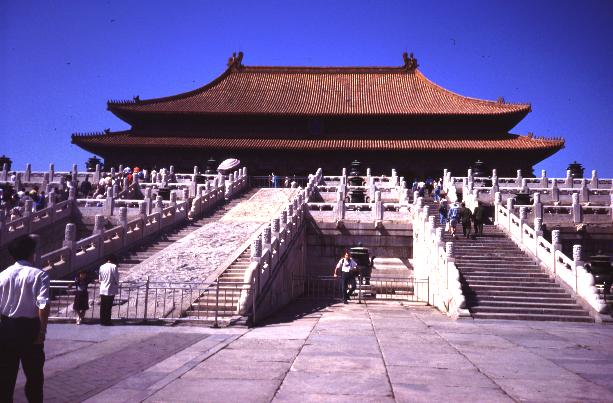
Mark recalls that Rinpoche pointed out the positions of five rocks, and wrote their names on the plan in Tibetan: Heaven, Earth, Bird, Tiger, and Man. In the photo below and in True Perception, The Path of Dharma Art, by Chögyam Trungpa, p. 65, Heaven (tall) and Earth (large) are on the right side of the ramp, and Bird (small) and Tiger (medium) are on the left side of the ramp. The rock outside of the “gate” of the two pillars is “Human.”
The ramp and rocks were to be surrounded by crushed white marble and raked as in a Japanese rock garden, like Ryoan-ji in Kyoto. The Ryōan-ji garden is considered one of the finest surviving examples of kare-sansui (dry landscape), a refined type of Japanese Zen temple garden design generally featuring distinctive larger rock formations arranged amidst a sweep of smooth pebbles–generally small, carefully selected polished river rocks raked into linear patterns that facilitate meditation.
Hector painted the dragons and the base of the walkway as Rinpoche directed. As is the custom in thangka painting, Hector suggested that Rinpoche open the eyes of the dragons after they were painted. Rinpoche agreed and did that one evening.
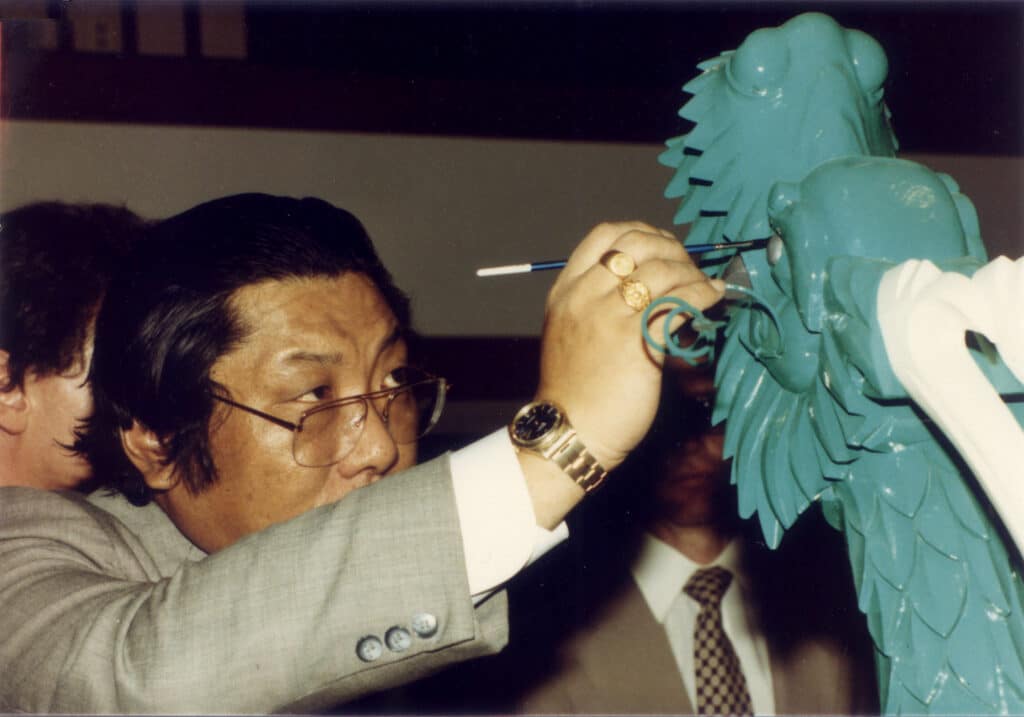
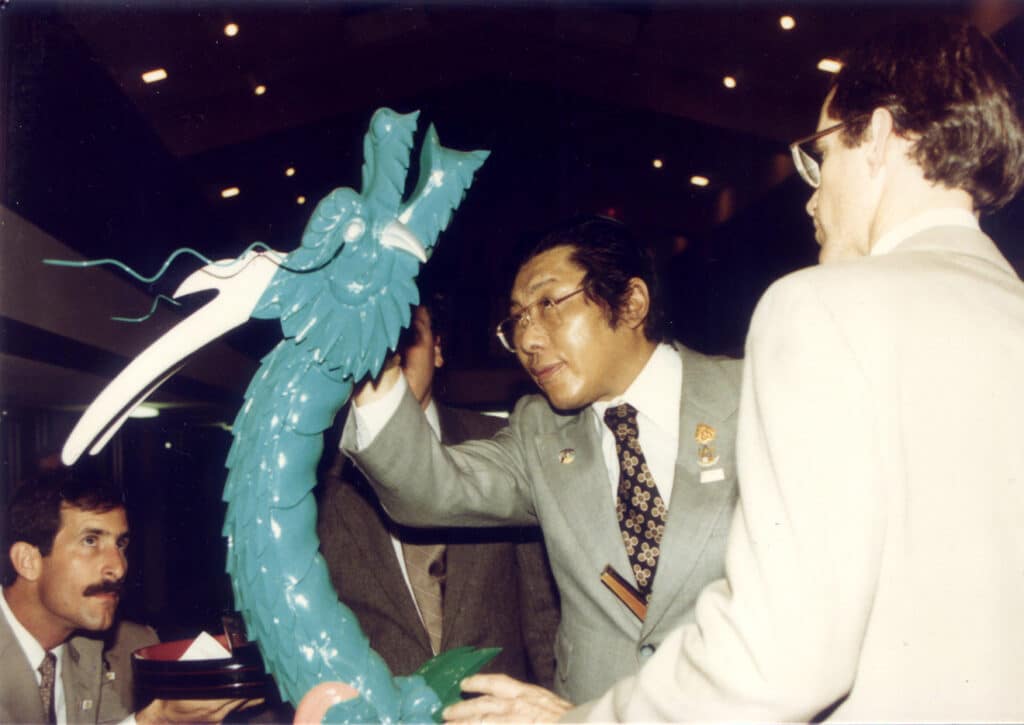
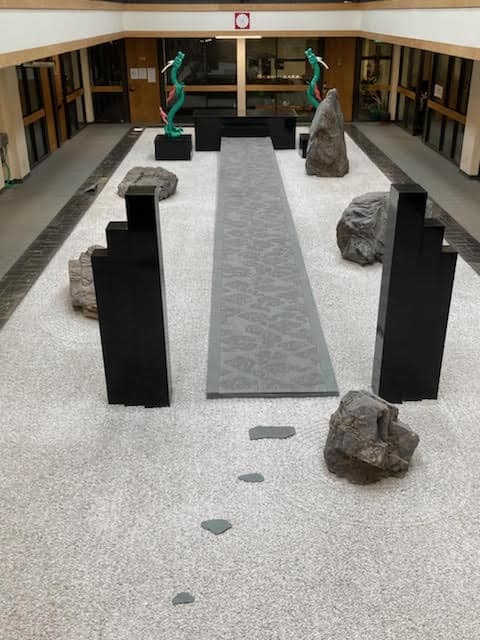
Earth Garden
On the Earth side, Paul Wegener helped Sensei for the first few days and built the raised mountain and waterfall in the southwest corner and also helped with the design and construction of the Zanchen An, or “Leftover Mind House.” Zanchen means “left-over mind,” which in Kyudo is the moment after the shot is released. “An” just means house, hut, hovel. The little house is inspired by the forest shelters the woodsmen in Japan make with bamboo. Here they used lodge-pole pine, the local equivalent. This structure in Shibata’s garden was a rustic tea house. Sensei worked very closely with the Blue Sky crew led by Mark Nowakowski. Sensei had no “architectural” plan, and communicated much of the design through symbolic hand gestures and quick, rough sketches. The house was built very quickly and spontaneously.
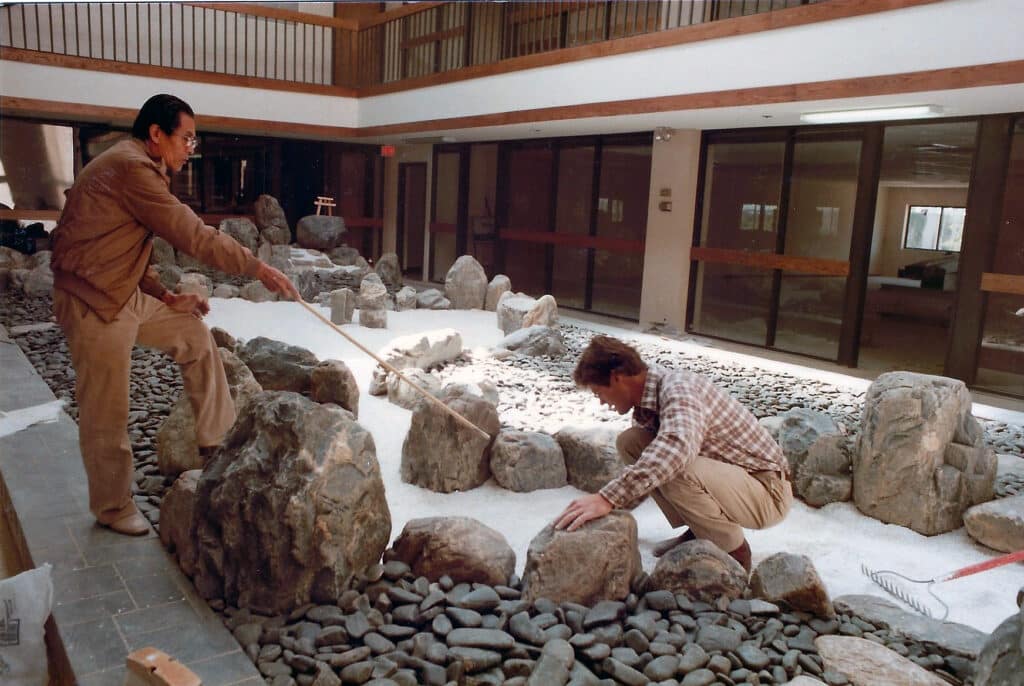
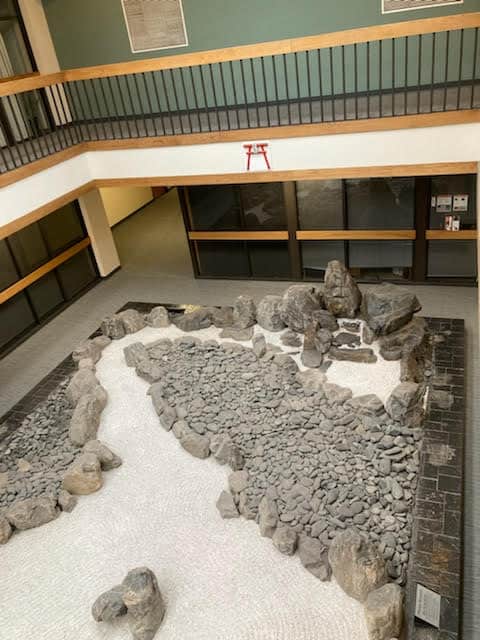
The white sand or aggregate represent water and the dark gray cobbles represent land. Shibata had specified black cobbles. They gathered the pebbles from the Cache de Poudre River near Drala Mountain Center. The gray Poudre pebbles were as black as they could get. In the photograph above, the greyness of the stones may be due to dust; the building maintenance was advised to hose down the pebbles periodically. The water sinks into the sand underneath and evaporates slowly. Shibata Sensei understood this situation and never complained that the stones were not black enough.
Matt Nowakowski and George Forge were assigned the job of placing rocks as instructed by Shibata Sensei, and worked with him for a month or so. The mountain and waterfall was raised first and then the river to the tea house was run. Matt recalls that they were given that job because of their understanding of who Sensei was and how to behave within decorum. They moved some of the rocks 100s of times without complaint. Part of their job was keeping Sensei from moving the rocks himself and hurting his back.
Sensei said that the Earth garden was feminine, and the Heaven garden was masculine. He described the symbolism for the Earth side. The surrounding garland of 108 medium-sized grey-blue stones was a mala, a Buddhist rosary. The outline of the mala describes the inner pattern of two connecting pools of crushed white marble, and the whole shape is the Chinese character “Hsin,” or Japanese “Kokoro,” meaning “heart / mind.” There is a rock in the center of each of the two pools. The larger rock is Buddha Amitabha, and the smaller rock is Fudo, a Japanese wrathful protector of the Buddha’s teachings.
At the completion of the Earth garden, the Blue Sky Crew joined Sensei for tea and/or beer in the Zanchen An tea house.
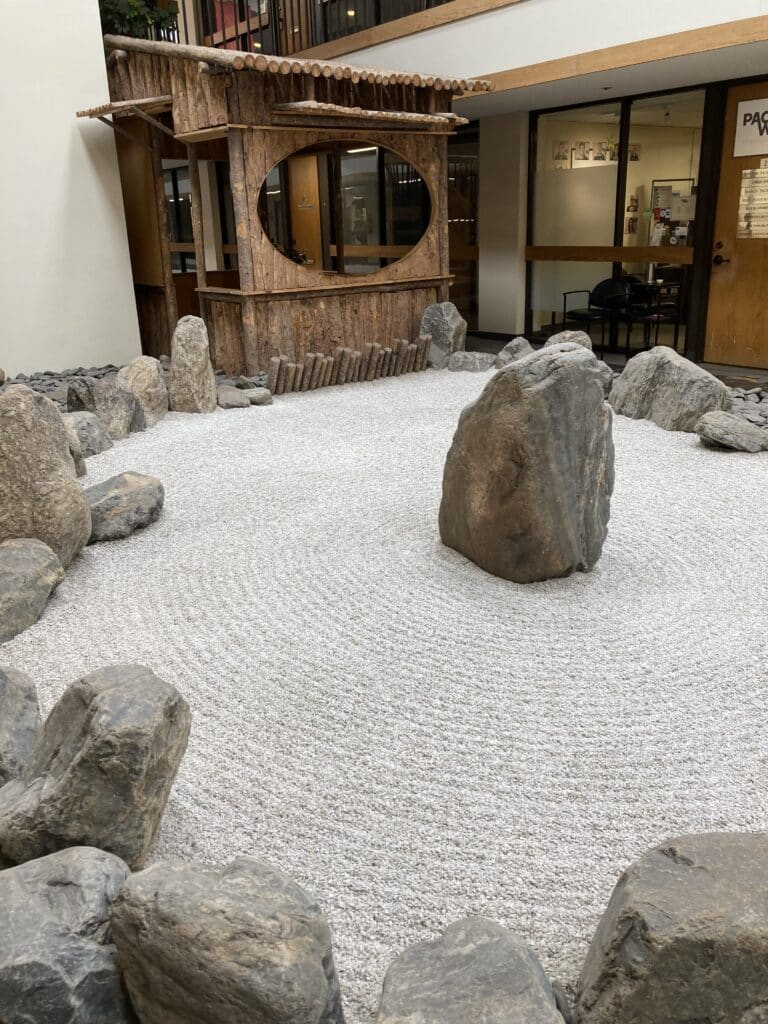
The development work for the entire building took about two years and was completed in 1985 or so. During that time, Nick made another trip to Japan to acquire the two dragons that Rinpoche had requested. Shibata Sensei knew where and how to get them and Nick commissioned them and had them shipped to Boulder at a cost of $10,000 each.
The official opening included two purification rituals – a lhasang smoke offering from Rinpoche’s Tibetan tradition and a Shihoberai ceremony from Sensei’s Kyudo tradition. Shihoberai is an ancient Japanese kyudo purification ritual that tames the kamis (energies of nature) of the six directions. Traditionally, arrows can be released into the air to symbolize heaven and into the ground to symbolize earth. Most often they were not physically fired, but released symbolically.
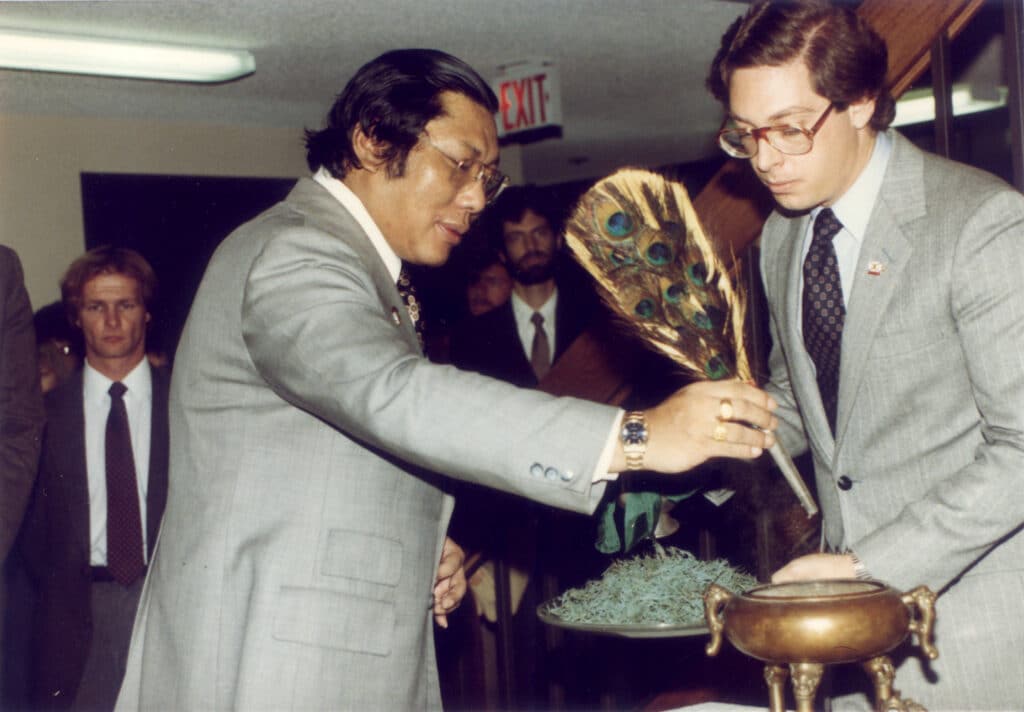
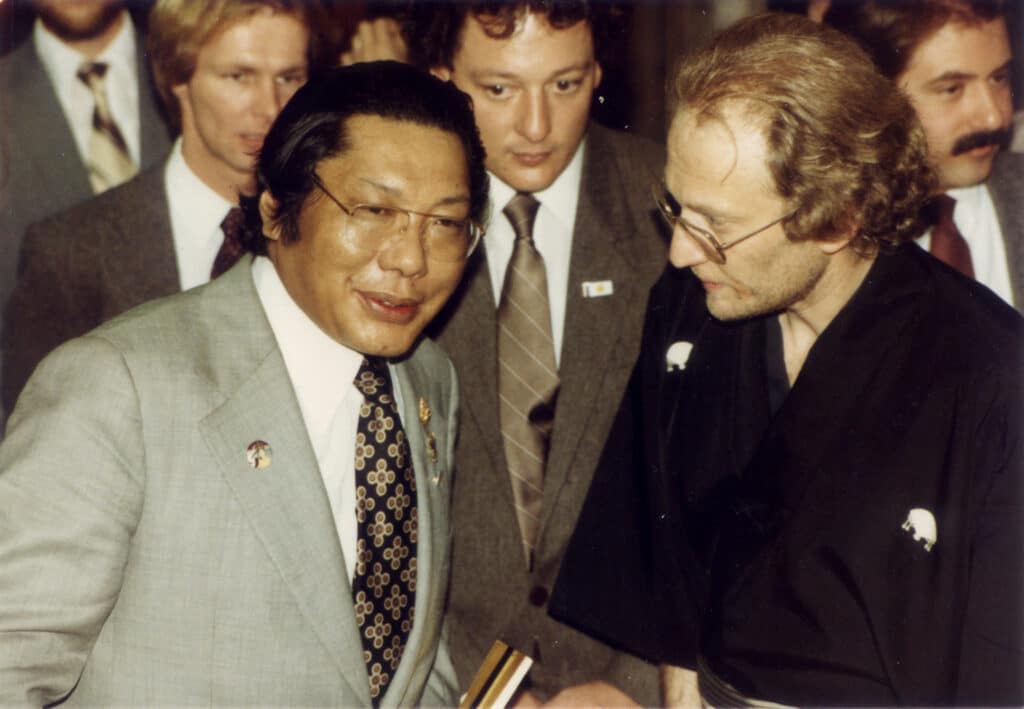
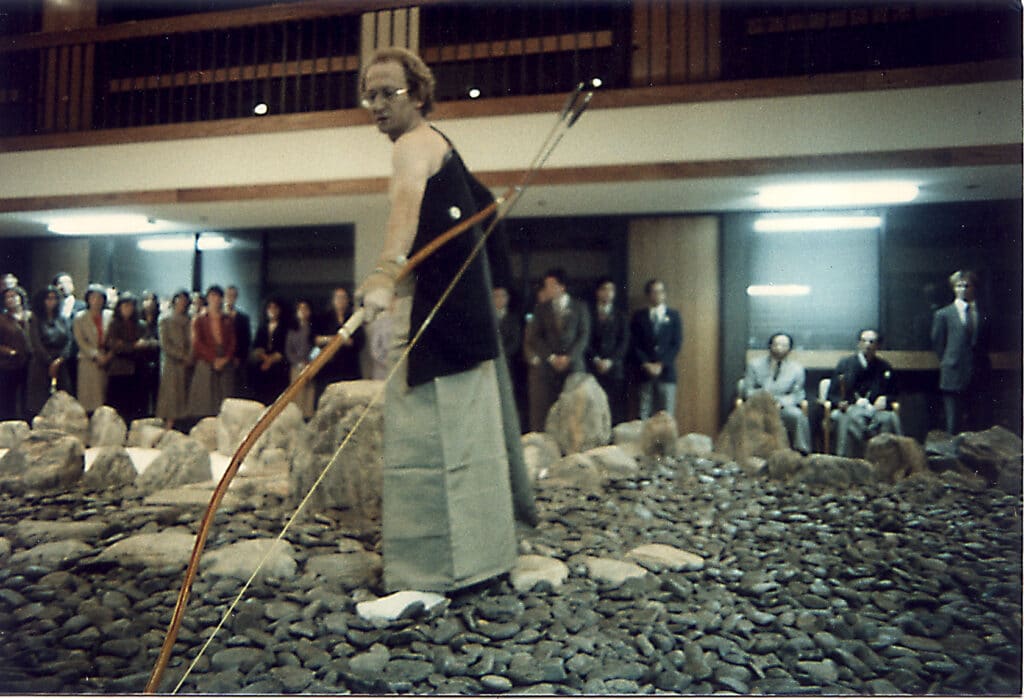
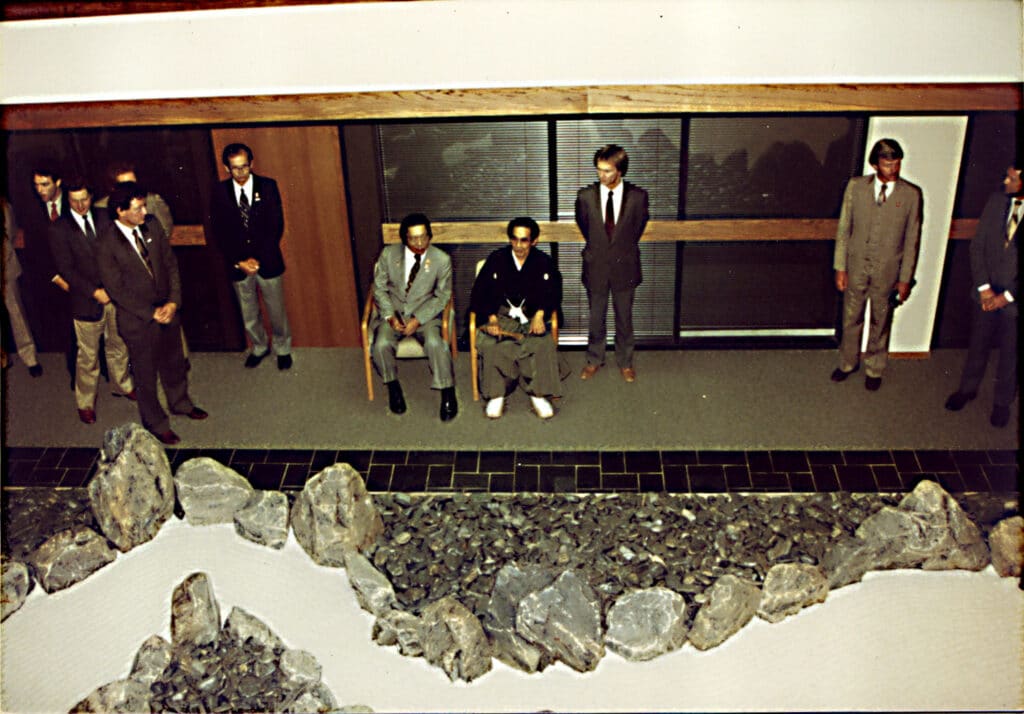
After the two installations were complete and Crossroads Gardens was filled with various business interests in offices around them, Nick approached James Gimian and Hudson Shotwell, owners of Trident Cafe and Booksellers on Pearl Street, to see whether they would open a small bar and coffee shop in the corner space of the Gardens near the parking entrance. This had previously been a small shop for tennis players.
After some deliberation, Shotwell and Gimian agreed to open the bar, incentivized by the low rent of $500/month. Getting the liquor license, designing and building the bar took six months, and in the end the space was decorated quite elegantly by Bob Rader.
Rinpoche was supportive of the Trident Cafe and Bar, even leaving his business card in the door if he passed by and it wasn’t open. However, due to a lack of business, the Trident Cafe and Bar closed a year later. Luckily, over the same period, sales at Trident Booksellers and Cafe on Pearl Street took off, and the upholstered booths, fixtures, chairs and tables were moved there, where they served beautifully for many years.
The fate of Crossroads Gardens was similar to the Trident Bar. With interest rates rising in that time of severe inflation from 14% to 18%, Nick couldn’t make the payments on the construction loan to remodel, install offices, and build the gardens. The bank foreclosed on the loan and eventually sold the building. However, the new owner appreciated the gardens and kept them as they were.





